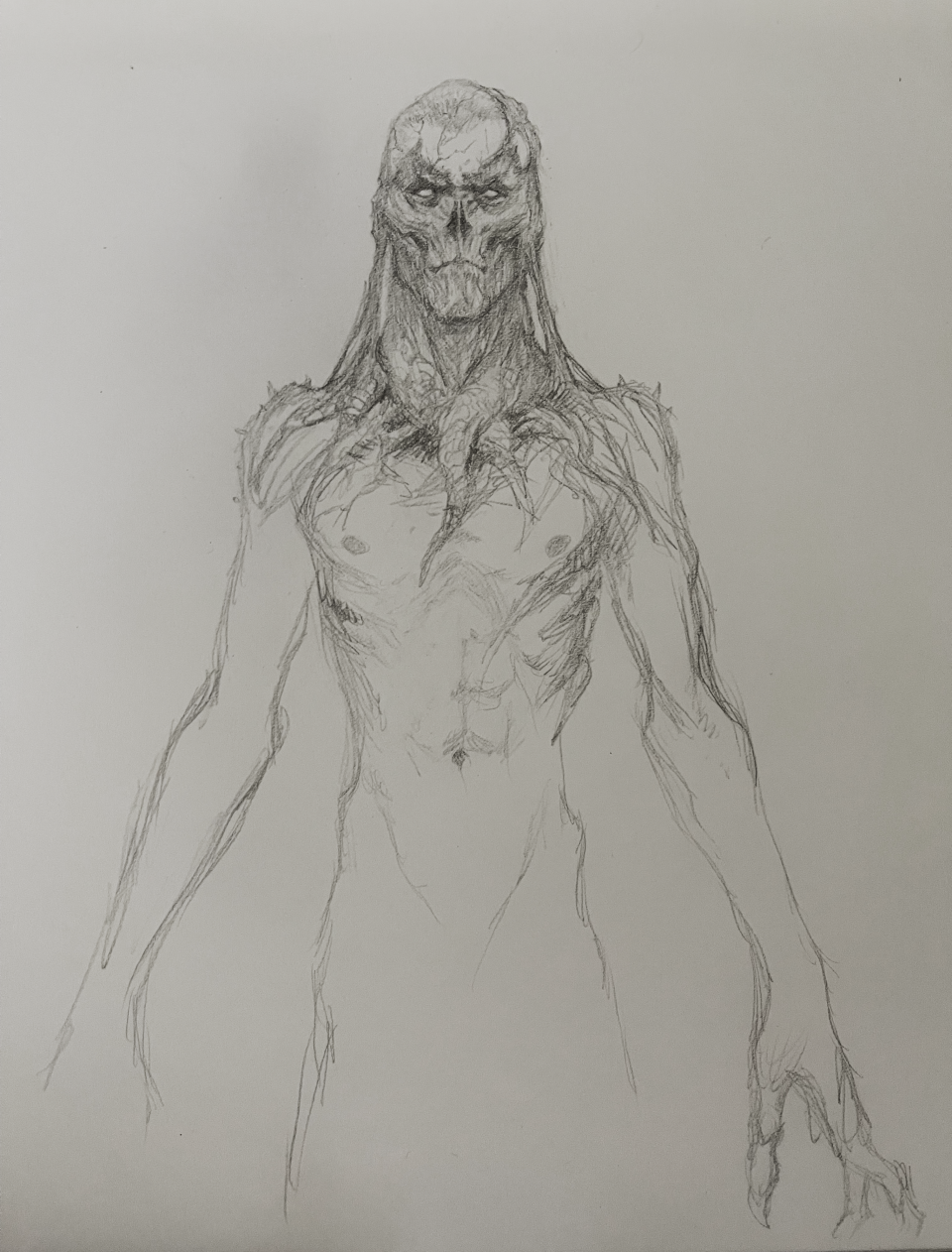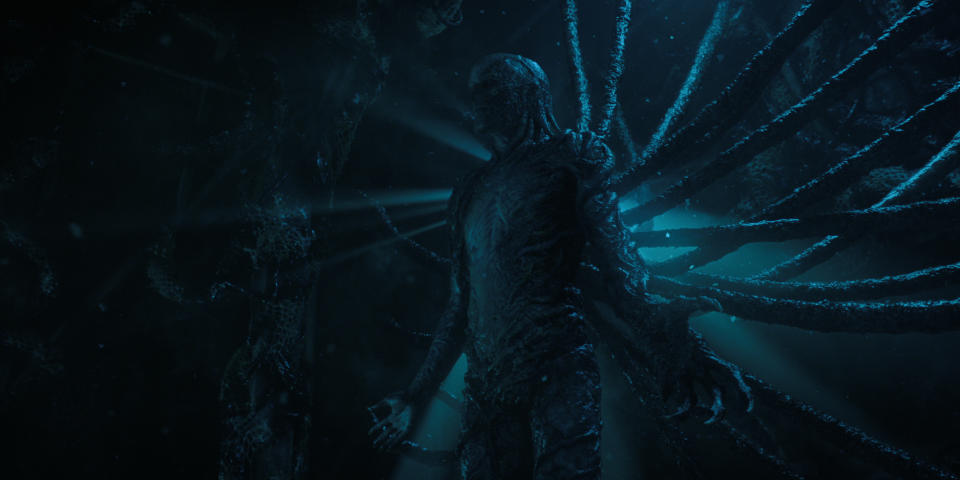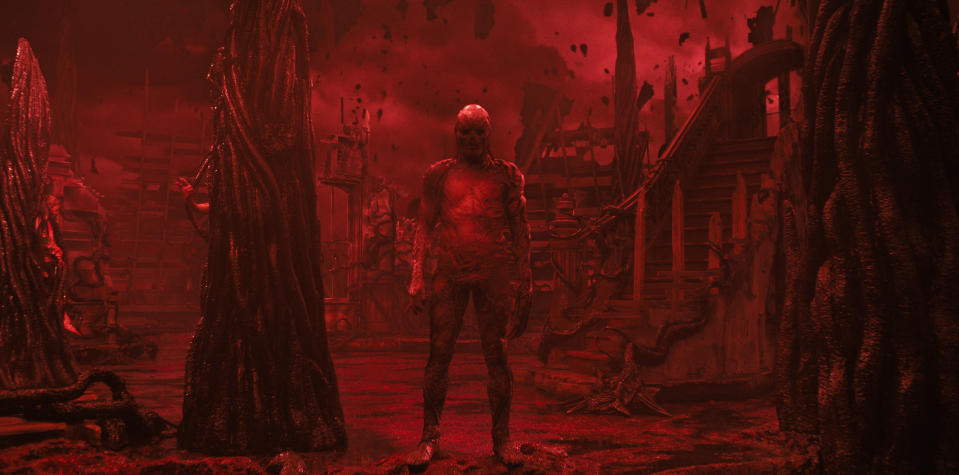‘Stranger Things’ Season 4: How the Duffer Brothers Channeled Freddy Krueger for the Vecna Monster

- Oops!Something went wrong.Please try again later.
- Oops!Something went wrong.Please try again later.
[Editor’s Note: The following story contains spoilers for “Stranger Things 4.”]
For the supersized, penultimate Season 4 of “Stranger Things” (Volume 1 is currently streaming on Netflix; Volume 2 premieres July 1), creators Matt and Ross Duffer channeled “A Nightmare on Elm Street” to give a more tangible horror vibe to their latest monster: Vecna, a humanoid creature from the Upside Down. Similar to the “Elm Street” franchise’s Freddy Krueger, Vecna preys on his victim’s minds, psychically manipulating their traumatic memories into terrifying hallucinations before murdering and possessing them.
More from IndieWire
'Top Gun: Maverick': How They Shot the High-Octane Cockpit Footage
Television Academy Tightens Emmys Eligibility Window by Ending Hanging Episode Rule
Vecna represents the series’ most ambitious creature work to date; it’s good enough that it could win the series’ first VFX Emmy. In a throwback to Season 1’s Demogorgon, the VFX team leaned more on practical effects than CG with Vecna. The Duffers wanted the creature to mirror shapes and textures from the Upside Down and its monstrous denizens: roots, vines, organic shapes, fibrous muscle. Vecna’s color palette also contains purple, dark red, black, and darker hues reminiscent of the Upside Down, which has visually taken over his body. Patches of exposed flesh, pale and anemic, demonstrate that he hasn’t seen sunlight in years — like a vampire.
“We wanted to use an actor with prosthetics to drive the character,” VFX supervisor Michael Maher told IndieWire. “But there was a lot of consideration [about the mix between practical and CG]. Does that mean we make the rest of the body CG? Do we want to do full CG with a face replacement? We’ve done full CG characters before [the Mind Flayers from Season 2], and it’s been awesome, but I’m so glad in this case, we went with leaning into the performance. I don’t think [the CG option] would’ve been as emotionally effective.”

Netflix
Vecna, unlike the other creatures, is a human who has mutated into a monster from overexposure to the Upside Down. He’s been subjected to the toxic environment for around 20 years and has become a part of it. His silhouette incorporates sharp shapes so that, even as a slow-moving character, his toothy appendages and jagged edges make him too dangerous to touch. His victims are trapped in the vines much like trophies.
All of these creepy details were built into Vecna’s full-body practical suit, which was created by prosthetics designer Barrie Gower (three-time Emmy winner for “Game of Thrones”) and his team. There were nearly 20 separate prosthetic appliances, done in a mixture of materials. Additionally, the Duffers wanted Vecna’s mutated left hand to be enlarged and distorted, with elongated fingers. Gower and his team made mechanical, aluminum-jointed finger extensions that extended the actor’s fingers up to 10 inches.
For the CG augmentation of Vecna, Maher turned to Rodeo FX, which previously did Season 3’s immense Mind Flayer. The work included a digital rendition of the mutated hand for close-up interactions with Vecna’s victims, vine-like texturing for the body, and replacing his nose and right pupil. “We did this crawling texture pattern on the vines that makes it look like they’re constantly moving, but very slowly,” Maher said. “The brothers wanted to do something that wasn’t too eye-catching or over-the-top. They didn’t want to detract from the performance, so this was no Davy Jones from ‘Pirates of the Caribbean.'”

Netflix
The most elaborate sequence in Volume 1 occurs in Episode 4 (“Dear Billy”), in which Max (Sadie Sink) gets trapped in Vecna’s mind lair, and narrowly escapes through a portal back home. The practical set is the most ambitious environment to date from series production designer Chris Trujillo, the Upside Down equivalent of a pivotal “Stranger Things” location, done up in the alternate dimension’s gnarled, organic iconography and red color palette. Its Hawkins counterpart is the attic where the Creel family was murdered in the 1950s; father Victor (original Freddy Krueger actor Robert Englund, deepening the “Elm Street” connections), was the lone survivor of the massacre, and was later convicted of the crimes and imprisoned in a psychiatric hospital. Thus, the Upside Down’s mysterious connection to Hawkins can be traced to what happened in that attic.
In addition to Vecna, Rodeo FX handled the CG environment of the mind lair as well. In fact, there were nearly as many VFX shots in the mind lair sequence as in all of Season 1. “The brothers were keen on it being a forest mixed with shards of the house that appear in fragments,” added Maher. “It’s the eerie, scary mind of a madman with broken memories. That was the brief.” The VFX studio created lightning, fake blood on a blue screen set that Max runs through on a high gloss flooring, and pieces of the house and boulders falling around her and exploding.

Netflix
“The Duffers wanted to push the explosiveness of it,” Maher continued. “Rodeo diced up its model and it would explode outward with huge splashes of [fake] blood. Max’s goal is to get to the portal, which was a ray of light through the clouds. It’s surreal where it rips away for a clear view into the cemetery. When she’s caught in the vines, that’s CG too. The texture matches Vecna, who’s in control of his environment and everything stems from him. He’s attached to the vines that lift him up. It’s like a spiderweb. Black widows are a big part of the season as a metaphor. Essentially, the vines in the Upside Down are coming and melding with him so he can get in this meditative state.”
The distinction of Season 4 for Maher was its darker tone and the opportunity to craft a more ominous environment as the series reaches its conclusion in Season 5. “As the kids grow, you need to abandon some of the immaturity and move into heavier themes,” he said. “The first season was about friendship and this season is more about power and responsibility and what can happen with too much power.”
Best of IndieWire
Emmy Predictions: Outstanding Documentary or Nonfiction Special
Emmy Predictions: Outstanding Documentary or Nonfiction Series
Sign up for Indiewire's Newsletter. For the latest news, follow us on Facebook, Twitter, and Instagram.


